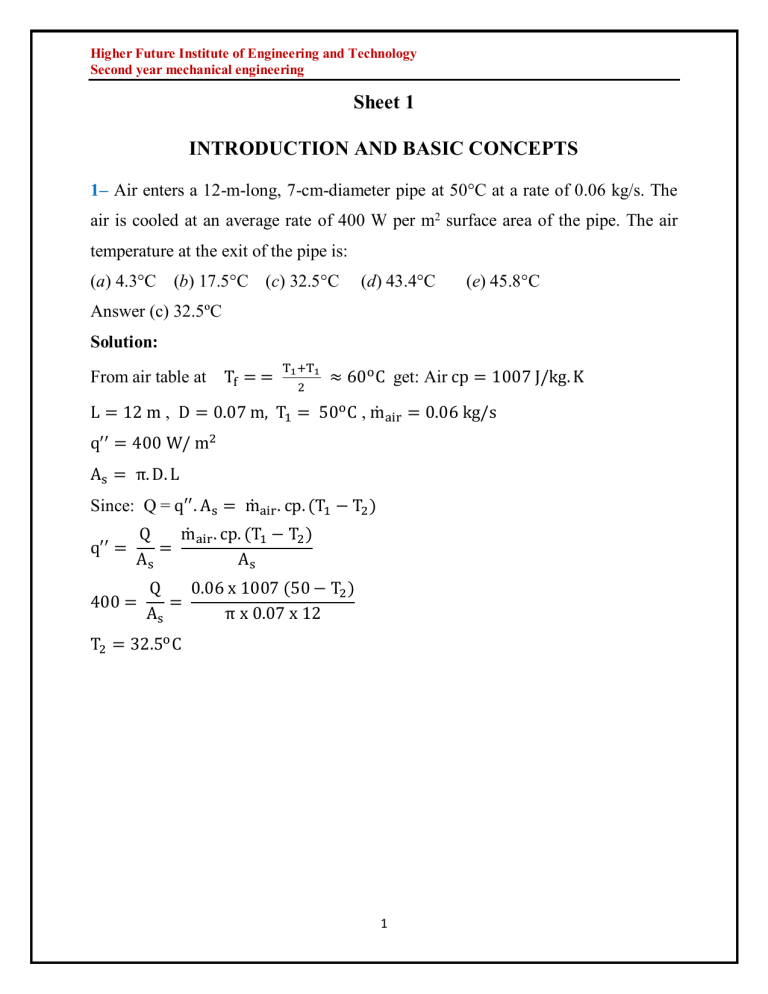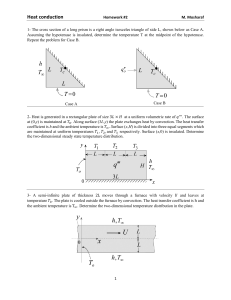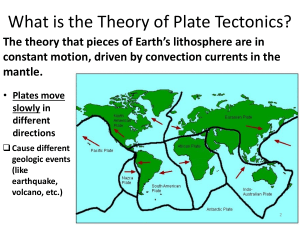
Higher Future Institute of Engineering and Technology Second year mechanical engineering Sheet 1 INTRODUCTION AND BASIC CONCEPTS 1– Air enters a 12-m-long, 7-cm-diameter pipe at 50°C at a rate of 0.06 kg/s. The air is cooled at an average rate of 400 W per m2 surface area of the pipe. The air temperature at the exit of the pipe is: (a) 4.3°C (b) 17.5°C (c) 32.5°C (d) 43.4°C (e) 45.8°C Answer (c) 32.5ºC Solution: From air table at Tf = = T1 +T1 2 ≈ 60o C get: Air cp = 1007 J/kg. K L = 12 m , D = 0.07 m, T1 = 50o C , ṁair = 0.06 kg/s q′′ = 400 W/ m2 As = π. D. L Since: Q = q′′ . As = ṁair . cp. (T1 − T2 ) q′′ = Q ṁair . cp. (T1 − T2 ) = As As 400 = Q 0.06 x 1007 (50 − T2 ) = As π x 0.07 x 12 T2 = 32.5o C 1 Higher Future Institute of Engineering and Technology Second year mechanical engineering 2 Higher Future Institute of Engineering and Technology Second year mechanical engineering 2– Heat is lost steadily through a 0.5-cm thick 2 m x 3 m window glass whose thermal conductivity is 0.7 W/m.K. The inner and outer surface temperatures of the glass are measured to be 12°C to 9°C. The rate of heat loss by conduction through the glass is: (a) 420 W (b) 5040 W (c) 17,600 W (d) 1256 W (e) 2520 W Answer (e) 2520 W Solution: 0.5 cm 𝐴 = 3𝑥2 = 6 𝑚2, ∆x = L = 0.005 m, T1 = 12o C , T2 = 9o C , 𝑘 = 0.7 𝑊/𝑚. 𝐾 Since: 𝑄 = 𝑘. 𝐴. (T1 −T2 ) ∆x = 0.7 𝑥 6 (12−9) 0.005 = 2520 𝑊 3 Higher Future Institute of Engineering and Technology Second year mechanical engineering 3– Steady heat conduction occurs through a 0.3-m-thick 9 m x 3 m composite wall at a rate of 1.2 kW. If the inner and outer surface temperatures of the wall are 15°C and 7°C, the effective thermal conductivity of the wall is: (a) 0.61 W/m.K (b) 0.83 W/m.K (c) 1.7 W/m.K (d) 2.2 W/m.K (e) 5.1 W/m.K Answer (c) 1.7 W/m⋅°C Solution: 𝐴 = 9𝑥3 = 27 𝑚2, ∆x = L = 0.3 m, T1 = 15o C , T2 = 7o C , 𝑄 = 1200 𝑊 𝑘 = 0.7 𝑊/𝑚. 𝐾 Since: 𝑄 = 𝑘. 𝐴. (T1 −T2 ) ∆x = 𝑘 𝑥 27 (15−7) 0.3 = 1200 𝑊 𝑘 = 1.7 𝑊/𝑚. 𝐾 4– Heat is lost through a brick wall (k = 0.72 W/m.K), which is 4 m long, 3 m wide, and 25 cm thick at a rate of 500 W. If the inner surface of the wall is at 22°C, the temperature at the midplane of the wall is: (a) 0°C (b) 7.5°C (c) 11.0°C (d) 14.8°C (e) 22°C Answer (d) 14.8ºC Solution : 𝐴 = 3𝑥4 = 12 𝑚2, ∆x = L = 0.25 m, Ti = 22o C, Tc = ? , To =? , 𝑄 = 500 𝑊 , 𝑘 = 0.72 𝑊/𝑚. 𝐾 Since: 𝑄 = 𝑘. 𝐴. (Ti −To ) ∆x = 𝑘. 𝐴. (Ti −Tc ) ∆x 2 ( ) 4 Higher Future Institute of Engineering and Technology Second year mechanical engineering 500 = 0.72 𝑥 12 (22 − To ) (22 − Tc ) = 0.72 𝑥 12 0.25 0.25 ) ( 2 To = 7.4o C Tc = 14.8o C 5– A 10-cm-high and 20-cm-wide circuit board houses on its surface 100 closely spaced chips, each generating heat at a rate of 0.12 W and transferring it by convection and radiation to the surrounding medium at 40°C. Heat transfer from the back surface of the board is negligible. If the combined convection and radiation heat transfer coefficient on the surface of the board is 22 W/m2.K, the average surface temperature of the chips is: (a) 41°C (b) 54°C (c) 67°C (d) 76°C (e) 82°C Solution: As = 0.1 x 0.2 = 0.02 𝑚2 , ℎ = 22 𝑊/𝑚 2 . 𝐾 Air, 𝑇∞ = 40𝑜 𝐶 𝑄 = 100 𝑥 0.12 = 12 𝑊 𝑄 = ℎ. As . (𝑇𝑠 − 𝑇∞ ) 𝑇𝑠 = 𝑇∞ + 𝑄 12 = 40 + = 67.2𝑜 𝐶 ℎ. As 22 𝑥 0.02 5 Higher Future Institute of Engineering and Technology Second year mechanical engineering 6– While driving down a highway early in the evening, the air flow over an automobile establishes an overall heat transfer coefficient of 18 W/m2.K. The passenger cabin of this automobile exposes 9 m2 of surface to the moving ambient air. On a day when the ambient temperature is 33°C, how much cooling must the air conditioning system supply to maintain a temperature of 20°C in the passenger cabin? (a) 670 W (b) 1284 W (c) 2106 W (d) 2565 W Answer (c) 2.6 MW Solution : As = 9 𝑚 2 , ℎ = 18 𝑊/𝑚 2 . 𝐾 Air, 𝑇∞ = 33𝑜 𝐶 𝑇𝑠 = 20𝑜 𝐶 𝑄 = ℎ. As . (𝑇𝑠 − 𝑇∞ ) = 18 𝑥 9 𝑥(33 − 20) = 2106 𝑊 6 (e) 3210 W Higher Future Institute of Engineering and Technology Second year mechanical engineering 7– A 25-cm-diameter black ball at 130°C is suspended in air, and is losing heat to the surrounding air at 25°C by convection with a heat transfer coefficient of 12 W/m2.K, and by radiation to the surrounding surfaces at 15°C. The total rate of heat transfer from the black ball is: (a) 217 W (b) 247 W (c) 251 W (d) 465 W (e) 2365 W Solution: Black Ball: 𝜀 = 1 𝐷 = 0.25 𝑚 As = 4π. 𝑅2 = π. 𝑑 2 = π. (0.25)2 = 0.1963 𝑚 2 Air, 𝑇∞ = 25𝑜 𝐶 = 25 + 273 = 298 𝐾 ℎ = 12 𝑊/𝑚 2 . 𝐾 𝑇𝑠 = 130𝑜 𝐶 = 130 + 273 = 403 𝐾 𝑇𝑠𝑢𝑟 = 15𝑜 𝐶 = 15 + 273 = 288 𝐾 𝑄𝑡𝑜𝑡𝑎𝑙 = 𝑄𝑐𝑜𝑛𝑣 + 𝑄𝑅𝑎𝑑 𝑄𝑐𝑜𝑛𝑣 = ℎ. As . (𝑇𝑠 − 𝑇∞ ) = 12 𝑥 π. (0.25)2 𝑥(130 − 25) = 247.4 𝑊 4 ] 𝑄𝑅𝑎𝑑 = 𝜀. 𝜎. As . [ 𝑇𝑠4 − 𝑇𝑠𝑢𝑟 𝑄𝑅𝑎𝑑 = 1 𝑥 5.67𝑥10−8 𝑥 π. (0.25)2 𝑥 [ (403)4 − (288)4 ] = 217 𝑊 𝑄𝑡𝑜𝑡𝑎𝑙 = 247.4 + 217 = 464.4 𝑊 7 Higher Future Institute of Engineering and Technology Second year mechanical engineering 8– A 3-m2 black surface at 140°C is losing heat to the surrounding air at 35°C by convection with a heat transfer coefficient of 16 W/m 2.K, and by radiation to the surrounding surfaces at 15°C. The total rate of heat loss from the surface is: (a) 5105 W (b) 2940 W (c) 3779 W (d) 8819 W (e) 5040 W Black Ball: 𝜀 = 1 A s = 3 𝑚2 Air, 𝑇∞ = 35𝑜 𝐶 = 35 + 273 = 308 𝐾 ℎ = 16 𝑊/𝑚 2 . 𝐾 𝑇𝑠 = 140𝑜 𝐶 = 140 + 273 = 413 𝐾 𝑇𝑠𝑢𝑟 = 15𝑜 𝐶 = 15 + 273 = 288 𝐾 𝑄𝑡𝑜𝑡𝑎𝑙 = 𝑄𝑐𝑜𝑛𝑣 + 𝑄𝑅𝑎𝑑 𝑄𝑐𝑜𝑛𝑣 = ℎ. As . (𝑇𝑠 − 𝑇∞ ) = 16 𝑥 3 𝑥(413 − 308) = 5040 𝑊 4 ] 𝑄𝑅𝑎𝑑 = 𝜀. 𝜎. As . [ 𝑇𝑠4 − 𝑇𝑠𝑢𝑟 𝑄𝑅𝑎𝑑 = 1 𝑥 5.67𝑥10−8 𝑥 3 𝑥 [ (413)4 − (288)4 ] = 3778 𝑊 𝑄𝑡𝑜𝑡𝑎𝑙 = 5040 + 3778 = 8818 𝑊 8 Higher Future Institute of Engineering and Technology Second year mechanical engineering 9– A person’s head can be approximated as a 25-cm diameter sphere at 35°C with an emissivity of 0.95. Heat is lost from the head to the surrounding air at 25°C by convection with a heat transfer coefficient of 11 W/m2.K, and by radiation to the surrounding surfaces at 10°C. Disregarding the neck, determine the total rate of heat loss from the head. (a) 22 W (b) 27 W (c) 49 W (d) 172 W (e) 249 W Solution: sphere: 𝜀 = 0.95 𝐷 = 0.25 𝑚 As = 4π. 𝑅2 = π. 𝑑 2 = π. (0.25)2 = 0.1963 𝑚 2 Air, 𝑇∞ = 25𝑜 𝐶 = 25 + 273 = 298 𝐾 ℎ = 11 𝑊/𝑚 2. 𝐾 𝑇𝑠 = 35𝑜 𝐶 = 35 + 273 = 308 𝐾 𝑇𝑠𝑢𝑟 = 10𝑜 𝐶 = 10 + 273 = 283 𝐾 𝑄𝑡𝑜𝑡𝑎𝑙 = 𝑄𝑐𝑜𝑛𝑣 + 𝑄𝑅𝑎𝑑 𝑄𝑐𝑜𝑛𝑣 = ℎ. As . (𝑇𝑠 − 𝑇∞ ) = 11 𝑥 π. (0.25)2 𝑥(308 − 298) = 21.6 𝑊 4 ] 𝑄𝑅𝑎𝑑 = 𝜀. 𝜎. 𝐴𝑠 . [ 𝑇𝑠4 − 𝑇𝑠𝑢𝑟 𝑄𝑅𝑎𝑑 = 0.95 𝑥 5.67𝑥10−8 𝑥 π. (0.25)2 𝑥 [ (308)4 − (283)4 ] = 28.77 𝑊 𝑄𝑡𝑜𝑡𝑎𝑙 = 21.6 + 27.4 = 49 𝑊 9 Higher Future Institute of Engineering and Technology Second year mechanical engineering 10– A room is heated by a 1.2 kW electric resistance heater whose wires have a diameter of 4 mm and a total length of 3.4 m. The air in the room is at 23°C and the interior surfaces of the room are at 17°C. The convection heat transfer coefficient on the surface of the wires is 8 W/m2.K. If the rates of heat transfer from the wires to the room by convection and by radiation are equal, the surface temperature of the wire is: (a) 3534°C (b) 1778°C (c) 1772°C (d) 98°C (e) 25°C Answer (b) 1778ºC Solution: Cylinder: 𝑄𝑡𝑜𝑡𝑎𝑙 = 1.2 𝑘𝑊 = 1200 𝑊 𝐷 = 0.004 𝑚 𝐿 = 3.4 𝑚 As = π. d. L = π x 0.004 x 3.4 = 0.0427 𝑚 2 Air, 𝑇∞ = 23𝑜 𝐶 ℎ = 8 𝑊/𝑚 2 . 𝐾 𝑇𝑠 = ? ? 𝐾 𝑇𝑠𝑢𝑟 = 17𝑜 𝐶 𝑆𝑖𝑛𝑐𝑒: 𝑄𝑐𝑜𝑛𝑣 = 𝑄𝑅𝑎𝑑 𝑎𝑛𝑑: 𝑄𝑡𝑜𝑡𝑎𝑙 = 𝑄𝑐𝑜𝑛𝑣 + 𝑄𝑅𝑎𝑑 = 1200 𝑊 𝑄𝑐𝑜𝑛𝑣 = 1200/2 = 600 𝑊 𝑄𝑐𝑜𝑛𝑣 = ℎ. As . (𝑇𝑠 − 𝑇∞ ) = 8 𝑥 π x 0.004 x 3.4 𝑥(𝑇𝑠 − 23) = 600 𝑊 𝑇𝑠 = 1778𝑜 𝐶 10 Higher Future Institute of Engineering and Technology Second year mechanical engineering 11– A person standing in a room loses heat to the air in the room by convection and to the surrounding surfaces by radiation. Both the air in the room and the surrounding surfaces are at 20°C. The exposed surface of the person is 1.5 m2 and has an average temperature of 32°C, and an emissivity of 0.90. If the rates of heat transfer from the person by convection and by radiation are equal, the combined heat transfer coefficient is: (a) 0.008W/m2.K (b) 3.0W/m2.K (c) 5.5W/m2.K (d) 8.3 W/m2.K (e) 10.9 W/m2.K Solution: Find the combined heat transfer coefficient is ℎ𝑐𝑜𝑚𝑏 : 𝑄𝑐𝑜𝑛𝑣 = 𝑄𝑅𝑎𝑑 𝜀 = 0.90 As = 1.5 𝑚 2 Air, 𝑇∞ = 20𝑜 𝐶 = 20 + 273 = 293 𝐾 ℎ𝑐𝑜𝑛𝑣 = ? ? 𝑊/𝑚 2 . 𝐾 𝑇𝑠 = 32𝑜 𝐶 = 32 + 273 = 305 𝐾 𝑇𝑠𝑢𝑟 = 20𝑜 𝐶 = 20 + 273 = 293 𝐾 𝑄𝑡𝑜𝑡𝑎𝑙 = 𝑄𝑐𝑜𝑛𝑣 + 𝑄𝑅𝑎𝑑 𝑄𝑐𝑜𝑛𝑣 = ℎ𝑐𝑜𝑛𝑣 . As . (𝑇𝑠 − 𝑇∞ ) = ℎ𝑐𝑜𝑛𝑣 𝑥 1.5 𝑥(32 − 20) 4 ] 𝑄𝑅𝑎𝑑 = 𝜀. 𝜎. 𝐴𝑠 . [ 𝑇𝑠4 − 𝑇𝑠𝑢𝑟 𝑄𝑅𝑎𝑑 = 0.90 𝑥 5.67𝑥10−8 𝑥 1.5𝑥 [ (305)4 − (293)4 ] = 98.25 𝑊 𝑄𝑡𝑜𝑡𝑎𝑙 = 2 𝑥 98.25 = 196.5 𝑊 = ℎ𝑐𝑜𝑚𝑏 . As . (𝑇𝑠 − 𝑇∞ ) = ℎ𝑐𝑜𝑚𝑏 𝑥1.5𝑥(32 − 20) ℎ𝑐𝑜𝑚𝑏 = 10.91 𝑊/𝑚 2 . 𝐾 11 Higher Future Institute of Engineering and Technology Second year mechanical engineering 12– The inner and outer surfaces of a 4-m x 7-m brick wall of thickness 30 cm and thermal conductivity 0.69 W/m.K are maintained at temperatures of 26°C and 8°C, respectively. Determine the rate of heat transfer through the wall, in W. Solution : 𝐴 = 4𝑥7 = 28 𝑚2, ∆x = L = 0.30 m, Ti = 26o C, To = 8o C , 𝑄 = ? ? 𝑊 , 𝑘 = 0.69 𝑊/𝑚. 𝐾 Since: 𝑄 = 𝑘. 𝐴. (Ti −To ) ∆x = 0.69 𝑥 28 (26−8) 0.30 𝑄 = 1159 𝑊 12 Higher Future Institute of Engineering and Technology Second year mechanical engineering 13– In a power plant, pipes transporting superheated vapor are very common. Superheated vapor is flowing at a rate of 0.3 kg/s inside a pipe with 5 cm in diameter and 10 m in length. The pipe is located in a power plant at 20°C, and has a uniform pipe surface temperature of 100°C. If the temperature drop between the inlet and exit of the pipe is 30°C, and the specific heat of the vapor is 2190 J/kg.K, Determine: 1-Tthe heat transfer coefficient of convection between the pipe surface and the surrounding. Steam: 𝑚̇𝑠𝑡 = 0.3 𝑘𝑔/𝑠 𝑐𝑃𝑠𝑡 = 2190 𝐽/𝑘𝑔. 𝐾 ∆𝑇𝑠𝑡 = 30𝑜 𝐶 𝐷 = 0.05 𝑚 𝐿 = 10 𝑚 As = π. d. L = π x 0.05 x 10 = 1.57 𝑚2 Air, 𝑇∞ = 20𝑜 𝐶 ℎ𝑐𝑜𝑛𝑣 = ? ? 𝑊/𝑚 2 . 𝐾 𝑇𝑠 = 100𝑜 𝐶 𝑄𝐿𝑜𝑠𝑠 = 𝑚̇𝑠𝑡 . 𝑐𝑃𝑠𝑡 . ∆𝑇𝑠𝑡 = ℎ𝑐𝑜𝑛𝑣 . As . (𝑇𝑠 − 𝑇∞ ) 𝑄𝐿𝑜𝑠𝑠 = 0.3 𝑥 2190 𝑥 30 = ℎ𝑐𝑜𝑛𝑣 𝑥 1.57𝑥(100 − 20) = 19710 𝑊 ℎ𝑐𝑜𝑛𝑣 = 19710 1.57𝑥(100−20) = 157 𝑊/𝑚 2. 𝐾 13 Higher Future Institute of Engineering and Technology Second year mechanical engineering 14– A transistors with a height of 0.4 cm and a diameter of 0.6 cm is mounted on a circuit board. The transistor is cooled by air flowing over it with an average heat transfer coefficient of 30 W/m2.K. If the air temperature is 55°C and the transistor case temperature is not to exceed 70°C. Determine: 1-The amount of power this transistor can dissipate safely. Disregard any heat transfer from the transistor base. Solution: 𝐷 = 0.6 𝑐𝑚 = 0.006 𝑚 𝐿 = 0.4 𝑐𝑚 = 0.004 𝑚 As = π. D. L = π x 0.006 x 0.004 = 7.54𝑥10−5 𝑚2 Air, 𝑇∞ = 55𝑜 𝐶 ℎ𝑐𝑜𝑛𝑣 = 30 𝑊/𝑚 2 . 𝐾 𝑇𝑠 = 70𝑜 𝐶 𝑄𝑐𝑜𝑛𝑣 = 30 𝑥 7.54 𝑥 10−5 𝑥(70 − 55) = 0.04 𝑊 14 Higher Future Institute of Engineering and Technology Second year mechanical engineering 15– Consider a person whose exposed surface area is 1.7 m2, emissivity is 0.5, and surface temperature is 32°C. Determine The rate of heat loss from that person by radiation in a large room having walls at a temperature of (a) 300 K and (b) 280 K. Answers: (a) 26.7 W, (b) 121 W 𝜀 = 0.5 As = 1.7 𝑚2 𝑇𝑠 = 32𝑜 𝐶 = 32 + 273 = 305 𝐾 𝑇𝑠 = 305 𝐾 𝑇𝑠𝑢𝑟 = 300 𝐾 4 ] 𝑄𝑅𝑎𝑑 = 𝜀. 𝜎. 𝐴𝑠 . [ 𝑇𝑠4 − 𝑇𝑠𝑢𝑟 𝑄𝑅𝑎𝑑−1 = 0.5 𝑥 5.67𝑥10−8 𝑥 1.7𝑥 [ (305)4 − (300)4] = 26.8 𝑊 𝑄𝑅𝑎𝑑−2 = 0.5 𝑥 5.67𝑥10−8 𝑥 1.7𝑥 [ (305)4 − (280)4] = 120.8 𝑊 15 Higher Future Institute of Engineering and Technology Second year mechanical engineering 16– A solid plate, with a thickness of 15 cm and a thermal conductivity of 80 W/m.K, is being cooled at the upper surface by air. The air temperature is 10°C, while the temperatures at the upper and lower surfaces of the plate are 50 and 60°C, respectively. Determine: 1-The convection heat transfer coefficient of air at the upper surface. Solution: Plate: ∆x = L = 0.15 m, Ts2 = 60o C, Ts1 = 50o C, Air: 𝑇∞ = 10𝑜 𝐶 ℎ𝑐𝑜𝑛𝑣 = ? ? 𝑊/𝑚 2 . 𝐾 Since: 𝑄 = 𝑘. 𝐴. (Ts2 −Ts1 ) 𝑞′′ = 80 𝑥 ∆x = ℎ𝑐𝑜𝑛𝑣 . As . (𝑇𝑠1 − 𝑇∞ ) (60−50) 0.15 = ℎ𝑐𝑜𝑛𝑣 𝑥 (50 − 10) ℎ𝑐𝑜𝑛𝑣 = 133.33 𝑊/𝑚 2 . 𝐾 16 𝑘 = 80 𝑊/𝑚. 𝐾 Higher Future Institute of Engineering and Technology Second year mechanical engineering 17– Air at 20oC with a convection heat transfer coefficient of 25 W/m2.K blows over a horizontal steel hot plate (k = 43 W/m.K). The surface area of the plate is 0.38 m2 with a thickness of 2 cm. The plate surface is maintained at a constant temperature of 𝑇𝑠 = 250 °C and the plate loses 300 W from its surface by radiation. Calculate the inside plate temperature 𝑇𝑖 . Solution: Plate: ∆x = L = 0.02 m, 𝑘 = 43 𝑊/𝑚. 𝐾, As = 0.38𝑚2 , Ts = 250o C, Air: 𝑇∞ = 20𝑜 𝐶 ℎ𝑐𝑜𝑛𝑣 = 25 𝑊/𝑚 2 . 𝐾 𝑄𝑅𝑎𝑑 = 300 𝑊 Since: 𝑄𝐶𝑜𝑛𝑑 = 𝑄𝑐𝑜𝑛𝑣 + 𝑄𝑅𝑎𝑑 𝑄𝐶𝑜𝑛𝑑 = 𝑘. 𝐴. (Ti − Ts ) = ℎ𝑐𝑜𝑛𝑣 . As . (𝑇𝑠 − 𝑇∞ ) + 𝑄𝑅𝑎𝑑 ∆x 𝑄 = 43 𝑥 0.38 (Ti −250) 0.02 = 25 𝑥 0.38 (250 − 20) + 300 Ti = 253𝑜 𝐶 17 Higher Future Institute of Engineering and Technology Second year mechanical engineering 18– Consider a person standing in a room at 20°C. Determine the total rate of heat transfer from this person if the exposed surface area and the skin temperature of the person are 1.7 m2 and 32°C, respectively, and the convection heat transfer coefficient is 5 W/m2.K. Take the emissivity of the skin and the clothes to be 0.9, and assume the temperature of the inner surfaces of the room to be the same as the air temperature. Solution: 𝜀 = 0.90 As = 1.7 𝑚2 Air, 𝑇∞ = 20𝑜 𝐶 = 20 + 273 = 293 𝐾 ℎ𝑐𝑜𝑛𝑣 = 5 𝑊/𝑚 2 . 𝐾 𝑇𝑠 = 32𝑜 𝐶 = 32 + 273 = 305 𝐾 𝑇𝑠 = 305 𝐾 𝑇𝑠𝑢𝑟 = 293 𝐾 𝑄𝑡𝑜𝑡𝑎𝑙 = 𝑄𝑐𝑜𝑛𝑣 + 𝑄𝑅𝑎𝑑 𝑄𝑐𝑜𝑛𝑣 = ℎ𝑐𝑜𝑛𝑣 . As . (𝑇𝑠 − 𝑇∞ ) = 5 𝑥 1.7 𝑥 (32 − 20) = 102 𝑊 4 ] 𝑄𝑅𝑎𝑑 = 𝜀. 𝜎. 𝐴𝑠 . [ 𝑇𝑠4 − 𝑇𝑠𝑢𝑟 𝑄𝑅𝑎𝑑 = 0.90 𝑥 5.67𝑥10−8 𝑥 1.7𝑥 [ (305)4 − (293)4 ] = 111 𝑊 𝑄𝑡𝑜𝑡𝑎𝑙 = 102 + 111 = 213 𝑊 18




